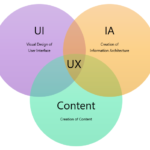User Experience Design (UX) encompasses much more than just UI. It involves optimizing the information architecture (IA), user interface (UI), content, and accessibility to solve user problems and improve conversion rates. On the other hand, UI design is primarily focused on the look, feel, and interactivity of the product interface.
A Quick Breakdown
UX (User Experience):
- Focuses on the overall feel and journey of a product and how users interact with it.
- Involves user research, creating personas, and designing a seamless user journey.
- Goals: Solve user problems, improve usability & satisfaction.
- Outputs: User personas, wireframes, prototypes, usability reports.
UI (User Interface):
- Deals with the visual elements and interactivity of a product.
- Focuses on the look & feel: buttons, icons, colors, etc.
- Goals: Make the interface intuitive, visually appealing, and interactive.
- Outputs: The final visual design: buttons, icons, color schemes, animations.
In a nutshell:
- UX is the why and how behind user interactions.
- UI is the what users see and interact with.
Both UX and UI are crucial for a successful product – they work together to create a product that’s both user-friendly and visually appealing.
Key differences:

- UX design deals with the broader scope including research, testing, and analysis, reducing friction for the user to achieve specific goals, while UI design deals with specific interface elements like buttons, icons, typography, colours, etc.
- UX design informs how a product should work while UI design informs how it should look.
- UX aims to improve usability, while UI aims to improve aesthetics.
- UX design is strategic and looks at the big picture including workflows, pain points and behaviours. UI design is tactical and looks at specific screens and interactions.
- UX design happens in the early stages to inform UI design. The UX helps shape the interface and experience. UI design then brings it to life visually.
- UX design is about solving user problems. UI design is about creating an intuitive, aesthetically-pleasing interface.
- UX design requires skills like empathy, problem-solving, and communication. UI design requires visual design skills and knowledge of tools like Photoshop.
One way of describing it is UX is about the overall feel, efficiency and usability, while UI is about the buttons, icons, and visuals. Effective products have both strong UX and UI that support each other to create great user experiences.


